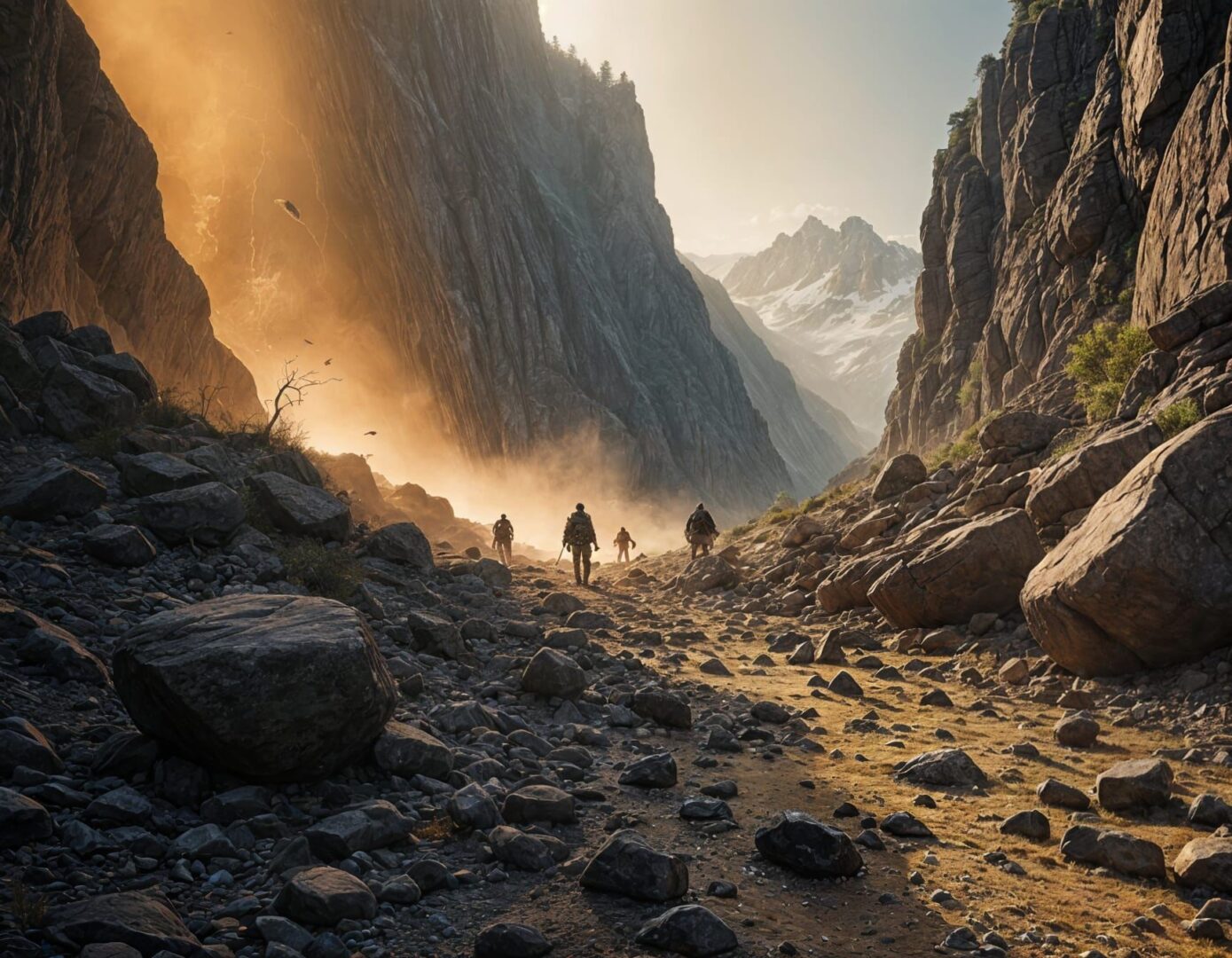
Avalanche of Ambush
Complexity: Complex
Type: Mechanical
Severity: Deadly
Trigger: Pressure Plates
Effect: Physical damage, difficult terrain
Damage Output: 6d10 to 24d10 bludgeoning damage based on character level (Bludgeoning)
Detection DC: Perception DC 15, Investigation DC 18
Disarm DC: Investigation DC 18, Dexterity (Sleight of Hand) DC 18
The Avalanche of Ambush begins subtly with a barely perceptible rumbling that vibrates beneath the adventurers’ feet, hinting at the impending chaos. Above, patches of loose rock cling precariously to the cliff face, shifting ominously as the wind howls sharply through the mountain pass. Nature has become a weapon forged by the brigands, hidden beneath the guise of simple stones and gravel. When triggered, the trap roars to life—massive boulders tumble with thunderous fury, hurtling toward the unsuspecting intruders. The air is filled with dust, debris, and a heart-stopping realization of danger as the avalanche crashes down around them, transforming the serene mountain landscape into a chaotic whirlwind of rock and ice.
Gameplay Notes for the Avalanche of Ambush Trap
Trap Activation
- Trigger Condition: The Avalanche of Ambush activates when a character steps onto one of the concealed pressure plates along the mountain path.
- Warning Mechanism: If any character passes within 10 feet of the plate, they can roll a DC 18 Dexterity saving throw. On a success, they can sense the impending danger (rumbling rocks and cracking ice). On failure, they step on the trap. This warning allows them to potentially take actions to prepare or evade.
- Activation Sequence: When activated, the trap begins a sequence of events over a span of rounds, symbolizing the avalanche cascading down from the cliff face.
Detection and Disarm Notes
-
Detection:
- Investigation or Perception Check: DC 18 to notice the poorly camouflaged pressure plates. Successful checks allow characters to pinpoint their locations.
- Nature/Survival Check: DC 15 to identify signs of a potential rockslide or destabilized ground.
- Arcana Check: DC 20 if the players suspect magic involvement; failure indicates they perceive no arcane influence.
-
Disarming:
- Pressure plates can be disarmed only if discovered first (DC 18 Investigation). Next, characters can attempt a DC 18 Dexterity (Sleight of Hand) to stack rocks over the plates.
- Powerful Impact Disarm: Characters can create a distraction using spells or sounds, which will require a group plan and a successful DC 15 Performance check to fool the trigger mechanism.
Suggested Tactics and Variations
- Vary the trap’s actions based on the character levels:
- For Level 1-4: Focus on immediate damage and standard effects.
- For Level 5-10: Add additional cascading effects, such as small rocks that occasionally fall, dealing 1d10 bludgeoning damage to random targets within a designated area.
- For Level 11-20: Include changing weather conditions after each round; the high winds impact ranged attacks, providing cover or heightening the chaos and difficulty of the encounter.
Initiative and Round Actions
- Trap Initiative: The trap rolls initiative using a +2 modifier, rolling 1d20.
-
Round Actions:
- Round 1 Action: On activation, all characters in a 60-foot cone take 6d10 bludgeoning damage. Affected characters must make a DC 15 Strength saving throw to avoid being knocked prone.
- Round 2 Action: The avalanche continues to rumble, causing minor rock slides (2d6 bludgeoning damage to characters within the affected area).
- Round 3 Action: Characters in the difficult terrain must make a DC 10 Dexterity saving throw, or they take an additional 2d6 bludgeoning damage if they fail.
- Subsequent Rounds: On each round after the first, the DM can choose to roll for more rock slides (1d10 for minor boulder falls targeting random characters).
Round-by-Round Effects
-
Phase 1 (Round 1):
- Initial effect: Characters within the cone take 6d10 bludgeoning damage.
- Save vs Prone: Non-successful characters knocked prone.
-
Phase 2 (Rounds 2-4):
- Rumble escalations: Characters within the area take 2d6 damage each round. Add dynamic effects based on player actions—if they manage to barricade an area, make the environment calmer for the duration.
-
Phase 3 (Ongoing from Round 5):
- Damage continues as described. Random boulder fall checks begin to occur each round, increasing the stress level and difficulty of survival.
- After 5 rounds, if not disabled, a more massive rock slide might occur, inflicting 12d10 damage on all characters in the affected cone.
Additional Tips for Running the Trap Smoothly
- Preparation: Get tokens or miniatures ready to indicate which characters are affected by Prone or hit by falling rocks for smooth tracking.
- Environmental Description: Describe the atmosphere with vivid sensory details (rush of wind, cloud of dust, chilling echoes) to maintain an immersive experience.
- Pacing: Speed up the rounds by having one player roll damage while the others describe their actions simultaneously.
- Player Agency: Allow players to use their skills creatively; if they come up with inventive ways to tackle the obstructions, reward them with advantages or bonuses.
- Health Status Management: Track players’ hit points discreetly and announce the cumulative damage at the start of each round for ongoing clarity.
This structured approach will allow for a dynamic and engaging experience while your players navigate the treacherous Avalanche of Ambush. Make sure to adapt to their actions and creative problem-solving to enhance their adventure!











